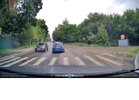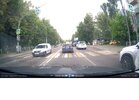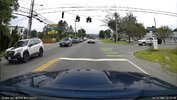Hmmm.... I would have thought that perhaps aiming the lens higher might be the way to go. The exposure is being determined by averaging the light hitting the sensor and adjusting to a target value for the recording. In the environment captured in the test images, there is quite a bit of dark (car, road, trees), which would tend to cause the adjustment to target value to cause some brightening. If the lens is aimed higher, thus including more bright sky, the firmware should make the exposure darker to hit the target value. Am I thinking this through incorrectly?
I'd also suggest testing in an environment where the ambient brightness is more evenly spread across the photo. Comparing that to the posted test photo might yield some insight into whether it's the camera or the environment affecting the unwanted overexposure.



